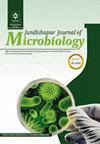伊朗拉什特市尿路致病性大肠杆菌分离株的血清群和致病性岛标记分布
IF 0.5
4区 医学
Q4 MICROBIOLOGY
引用次数: 0
摘要
背景:尿路感染是世界各地医院和社区最常见的感染之一。目的:鉴于尿路致病性大肠杆菌(UPEC)引起的尿路感染在医学上的重要性,本研究旨在调查致病性岛(PAI)标志物、O-抗原血清群以及与Rasht市医院住院患者的UPEC分离株相关的抗生素耐药性。方法:从伊朗拉什特选定医院转诊的尿路感染患者身上共采集110份尿液样本。采用双纸片协同试验(DDST)检测分离株产超广谱β-内酰胺酶(ESBL)的能力。使用特定的引物,检测到8种PAI(即,PAI I536、PAI II536、PAI III536、PAI IV536、PAI ICFT073、PAI IICFT073,PAI IJ96和PAI IIJ96)。结果:从药敏模式来看,萘啶酸和复方三恶唑的耐药率较高(81.8%),阿米卡星的耐药率最高(85.5%),双纸片协同试验显示ESBL阳性菌株的发生率为62.7%(69/110)。在110个UPEC分离株中,106个(96.4%)携带至少一种所研究的PAI标记。具有PAI IV536的UPEC分离株(81.8%)的患病率最高,PAI J196(6.4%)的PAI标记物最低。最主要的O血清群是O25(36.4%),其次是O16(17.3%),而O4和O7血清群(0.9%)是UPEC分离株中最低的血清群。结论:我们菌株的特征揭示了PAI和血清群的共存,证实了不同血清群和PAI标记物之间抗生素耐药性的重要性。我们的研究结果有可能应用于流行病学研究和设计针对UPEC引起的尿路感染的UTI治疗策略。本文章由计算机程序翻译,如有差异,请以英文原文为准。
Serogroup and Pathogenicity Island Marker Distributions Among Uropathogenic Escherichia coli Isolates in Rasht, Iran
Background: Urinary tract infections (UTIs) are among the most prevalent infections in hospitals and communities worldwide. Objectives: Due to the medical importance of UTIs caused by uropathogenic Escherichia coli (UPEC), this study aimed to investigate pathogenicity island (PAI) markers, O-antigen serogroups, and resistance to antibiotic agents associated with UPEC isolates obtained from hospitalized patients in Rasht city hospitals. Methods: A total of 110 urine samples were taken from patients with UTI referred to selected hospitals in Rasht, Iran. The double-disk synergy test (DDST) was used to detect the isolate’s ability to produce extended-spectrum β-lactamase (ESBL). Using particular primers, eight PAIs were detected (ie, PAI I536, PAI II536, PAI III536, PAI IV536, PAI ICFT073, PAI IICFT073, PAI IJ96, and PAI IIJ96). Results: According to the antibiotic susceptibility pattern, a high level of antibiotic resistance was observed against nalidixic acid (81.8%) and co-trimoxazole (78.2%), while the most effective agent was amikacin (85.5%). Double-disk synergy test revealed that the incidence of ESBL-positive strains was 62.7% (69/110). Of the 110 UPEC isolates, 106 (96.4%) carried at least one of the investigated PAI markers. UPEC isolates with PAI IV536 (81.8%) had the highest prevalence, and PAI J196 (6.4%) had the lowest PAI marker. The most predominant serogroup O was O25 (36.4%), followed by O16 (17.3%), while the O4 and O7 serogroups (0.9%) were the lowest serogroups among UPEC isolates. Conclusions: The characterization of our strain revealed the co-occurrence of PAI and serogroups, confirming the importance of antibiotic resistance among the distinct serogroups and PAI markers. Our results have potential application for epidemiological studies and designing UTI treatment strategies against UTIs caused by UPEC.
求助全文
通过发布文献求助,成功后即可免费获取论文全文。
去求助
来源期刊

Jundishapur Journal of Microbiology
MICROBIOLOGY-
CiteScore
1.30
自引率
0.00%
发文量
56
审稿时长
6-12 weeks
期刊介绍:
Jundishapur Journal of Microbiology, (JJM) is the official scientific Monthly publication of Ahvaz Jundishapur University of Medical Sciences. JJM is dedicated to the publication of manuscripts on topics concerning all aspects of microbiology. The topics include medical, veterinary and environmental microbiology, molecular investigations and infectious diseases. Aspects of immunology and epidemiology of infectious diseases are also considered.
 求助内容:
求助内容: 应助结果提醒方式:
应助结果提醒方式:


